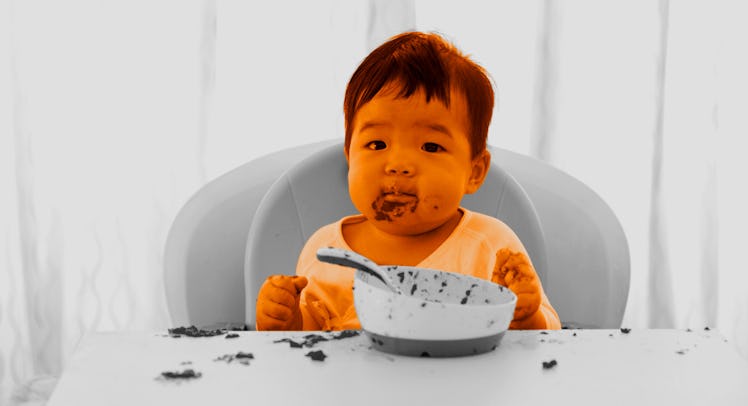The Developmental Benefits Of Messy Eating For Toddlers
Embrace the mess.

Messy kids are frustrating, particularly during family dinner time. But thankfully there is a simple solution. If you’re fighting a battle over dinner mess, you should consider letting your kid win. Because not only is it adorable to see a kid grinning ear-to-ear while covered in breakfast, but also research links messy eating to increased word learning in toddlers. So, the sooner you succumb to the slop, the sooner your kid will be complimenting you on the delicious meal … that they’ve rubbed into their hair.
Dr. Larissa Samuelson is a psychology professor at the University of East Anglia in the U.K., who specializes in cognitive development, specifically early word and category learning. She helped author a 2013 study that found toddlers’ ability to assign names to certain things is context-dependent — and, by “certain things,” they mean half your kid’s diet, and by “context,” they mean the kid’s high chair.
Samuelson’s team presented 16-month-olds with tasty non-solids and assigned them fake names, then offered the same foods in different sizes and shapes moments later. The kids who got the messiest and were in high chairs, as opposed to other venues, performed best at correctly identifying and naming the foods. So on the plus side, you can keep fighting the “Don’t eat off the floor” battle.
How to Help a Kid Make Meaningful Messes
- Create a comfortable context: The high chair should be a setting where you both feel free — for them to make a mess and you to let them. Your responsiveness matters, so eliminate stress and distraction with a good floor mat and easy-to-clean tray. Avoid carpet at all costs.
- Expand the context outward: For example, help your kid understand how water looks on the high chair tray, then watch them discover how it looks in the bathtub. Try taking the same toys from one to the other — it’ll help your kid carry their new knowledge between experiences and make those connections. It’s called “scaffolding,” and you probably already do it without realizing, so congrats on being a parenting expert.
- They may flat-out reject something too novel: “For you, it could be surprising, like, ‘What the heck? This isn’t going to bite you.’ But kids need to explore and learn on their own,” Samuelson says. So they’re not ready for pudding yet. Their loss is your sweet, sweet gain.
- Trying to redirect their attention is a losing battle: In the context of word learning, follow whatever your kid’s interested in. “Kids are good at balancing and exploring different things; let them have what they want. Another time, when they’ve had a better nap and are more up for trying new things, go for it.”
Dr. Samuelson explains the research like so: Imagine you’re 16 months old and staring down a cup of milk and a cup of glue. Sure, both are delicious, but how would you tell the difference just by looking? While solids are often defined and named by their shapes or features, non-solids are generally named according to their material, perceptual cues you take for granted but with which a 16-month-old has little experience. So the 16-month-old ends up poking and squeezing and throwing the contents of those 2 cups to figure out what they are before screaming, “Mmm, paste!” and diving in. “To know what it is, you have to get your hands in there, play with it, and get messy,” Dr. Samuelson says.
Sounds reasonable (and fun) enough, but why does the high chair matter? Most of your toddler’s experience with non-solids comes from eating them, and most of their eating happens in a high chair. It’s in that context where your kid knows it’s safe to turn yogurt into paint, as opposed to when they do that on the carpet and you get all bent out of shape.
Aside from having the youngest kid in the playgroup who can say “Gluten-free green juice,” here’s why you should care: Messy kids aren’t smarter per se, an erroneous (and common!) conclusion Dr. Samuelson is quick to deflect. However, higher vocabulary generally correlates with better executive function — the ability to apply rules to situations and control behavior appropriately. “Sit in the circle during story time, get up and run during recess time, and know which is which,” says Dr. Samuelson, who has clearly never seen your kid’s preschool class. Letting kids get messy in particular contexts also aids motor skills and general cognition. For example, finger painting helps kids identify substances and learn how colors blend.
Importantly, play and learning are not opposites: “There is a general move towards pushing very academic learning younger and younger, but some things are best learned by getting your hands in there and messing and experimenting and playing,” says Dr. Samuelson. “Sitting kids at tables and having them do worksheets is detrimental. They can’t make the same connections or have the same first-person experience. They can’t learn it in the same way. Play is active engagement, experimentation, and learning. It’s critical.”